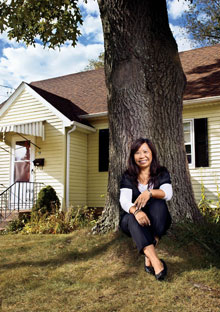O's Eco Makeover

Photo: Michael Edwards
In our latest Make Me a Ten! makeover, a woman buying her first house gets advice on how to live a little greener.
Silvia Chan, 40, has just closed on her first house. Many homebuyers in her shoes would be obsessing about paint colors, mortgage payments, or whether there's a budding drummer next door. But Silvia is fixated on the environmental impact of her 1,200-square-foot home in Manchester, Connecticut. "I'm not a green extremist," says Silvia, the associate director of the University of Connecticut's recreation center. "I eat meat, and I will always use toilet paper. But I have children in my life—a nephew and two godchildren—and I want to leave the planet in good condition for them." She's also been inspired by her outdoor passions: whitewater rafting, hiking, and ice climbing. "The first rule in the wilderness is leave no trace," Silvia says. "If that's the rule of my recreational life, why not my daily life, too?" She knows the basics—swapping traditional lightbulbs for fluorescent ones, buying local produce —but she's not sure what to do next. Enter Michelle Madden, CEO of GreenYour.com , an online resource for eco-friendly living. At Silvia's new house, Michelle says she should put each decision to the same litmus test: Does it help the planet? Does it help my health? Does it help my finances? If Silvia answers yes to one of the questions (or even better, two), then that's a change to make.
Although Silvia is eager to do her part for the environment, her home-improvement wish list includes a few wildly un-green choices, such as a 26-cubic-foot refrigerator. The thought of that appliance sends Michelle to DEFCON 4. "One way to reduce energy costs is to keep a refrigerator at least two-thirds full," she explains. "Then it doesn't have to work so hard to cool when you open and close the door." Living alone, Silvia likely won't be able to keep a fridge that size even half full. Silvia agrees to consider a smaller model. She had thought that as long as an appliance was Energy Star certified, it was a green choice. She didn't know that manufacturer buying guides recommend 14-cubic-feet refrigerators for homes in which two people live.
As Michelle walks through the house, she offers a number of eco-options; Silvia is excited but overwhelmed, so Michelle encourages her to focus on a few tips. "Individually we have enormous power to make small changes," says Michelle. "Once you make those small changes, you become aware of bigger changes—and other people's behavior, government policy, what corporations are doing. You start voting, sometimes just with your wallet." For instance, Silvia says she'll stop buying candles that contain paraffin (a petroleum product). "The more people make choices like this, the more it will affect which products are brought to market, which are taken off the shelves," says Michelle. "By switching one habit, people can impact an entire industry—small things can become big things."
See Michelle's Green Plan: Save money—and the planet—with these simple changes
Keep Reading
| 17 ways to save money—and the planet |  What "green" really means |  Can you lose weight by going green? |



